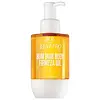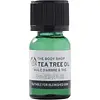What's inside
What's inside
 Key Ingredients
Key Ingredients

 Benefits
Benefits

 Concerns
Concerns

 Ingredients Side-by-side
Ingredients Side-by-side

Caprylic/Capric Triglyceride
MaskingHelianthus Annuus Seed Oil
EmollientOlea Europaea Fruit Oil
MaskingMacadamia Integrifolia Seed Oil
Skin ConditioningSimmondsia Chinensis Seed Oil
EmollientCocos Nucifera Oil
MaskingParfum
MaskingSqualane
EmollientPaullinia Cupana Fruit Extract
Skin ConditioningPtychopetalum Olacoides Bark/Root Extract
EmollientPlinia Cauliflora Fruit Extract
Skin ConditioningPlankton Extract
Skin ConditioningEuterpe Oleracea Fruit Oil
Skin ConditioningAmaranthus Caudatus Seed Extract
Skin ConditioningTriticum Vulgare Germ Extract
Skin ConditioningHordeum Distichon Extract
Skin ProtectingTocopherol
AntioxidantEthylhexylglycerin
Skin ConditioningBenzyl Alcohol
PerfumingBenzyl Salicylate
PerfumingCoumarin
PerfumingHydroxycitronellal
PerfumingLimonene
PerfumingLinalool
PerfumingBenzyl Benzoate
AntimicrobialCitral
PerfumingEugenol
PerfumingCaprylic/Capric Triglyceride, Helianthus Annuus Seed Oil, Olea Europaea Fruit Oil, Macadamia Integrifolia Seed Oil, Simmondsia Chinensis Seed Oil, Cocos Nucifera Oil, Parfum, Squalane, Paullinia Cupana Fruit Extract, Ptychopetalum Olacoides Bark/Root Extract, Plinia Cauliflora Fruit Extract, Plankton Extract, Euterpe Oleracea Fruit Oil, Amaranthus Caudatus Seed Extract, Triticum Vulgare Germ Extract, Hordeum Distichon Extract, Tocopherol, Ethylhexylglycerin, Benzyl Alcohol, Benzyl Salicylate, Coumarin, Hydroxycitronellal, Limonene, Linalool, Benzyl Benzoate, Citral, Eugenol
 Reviews
Reviews

Ingredients Explained
These ingredients are found in both products.
Ingredients higher up in an ingredient list are typically present in a larger amount.
Citral is a fragrance and used to add a lemon-like scent to products. It is both naturally found in plants and created synthetically. In plants, it is commonly occurring in lemon myrtle, lemongrass, lemon tea-tree, lemon verbena, and other citruses.
The EU mandates Citral be listed separately as a fragrance. It is a known allergen and may cause contact dermatitis. Citral can also used as a masking ingredient.
The term 'fragrance' is not regulated in many countries. In many cases, it is up to the brand to define this term. For instance, many brands choose to label themselves as "fragrance-free" because they are not using synthetic fragrances. However, their products may still contain ingredients such as essential oils that are considered a fragrance.
The term 'citral' is a collective term for two geometric isomers: geranial/Citral A and neral/Citral B.
Learn more about CitralLimonene is a fragrance that adds scent and taste to a formulation.
It's found in the peel oil of citrus fruits and other plants such as lavender and eucalyptus. The scent of limonene is generally described as "sweet citrus".
Limonene acts as an antioxidant, meaning it helps neutralize free radicals.
When exposed to air, oxidized limonene may sensitize the skin. Because of this, limonene is often avoided by people with sensitive skin.
The term 'fragrance' is not regulated in many countries. In many cases, it is up to the brand to define this term. For instance, many brands choose to label themselves as "fragrance-free" because they are not using synthetic fragrances. However, their products may still contain ingredients such as essential oils that are considered a fragrance.
Learn more about LimoneneTocopherol (also known as Vitamin E) is a common antioxidant used to help protect the skin from free-radicals and strengthen the skin barrier. It's also fat soluble - this means our skin is great at absorbing it.
Vitamin E also helps keep your natural skin lipids healthy. Your lipid skin barrier naturally consists of lipids, ceramides, and fatty acids. Vitamin E offers extra protection for your skin’s lipid barrier, keeping your skin healthy and nourished.
Another benefit is a bit of UV protection. Vitamin E helps reduce the damage caused by UVB rays. (It should not replace your sunscreen). Combining it with Vitamin C can decrease sunburned cells and hyperpigmentation after UV exposure.
You might have noticed Vitamin E + C often paired together. This is because it is great at stabilizing Vitamin C. Using the two together helps increase the effectiveness of both ingredients.
There are often claims that Vitamin E can reduce/prevent scarring, but these claims haven't been confirmed by scientific research.
Learn more about Tocopherol